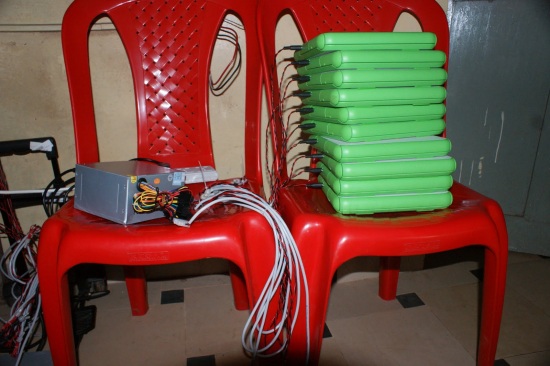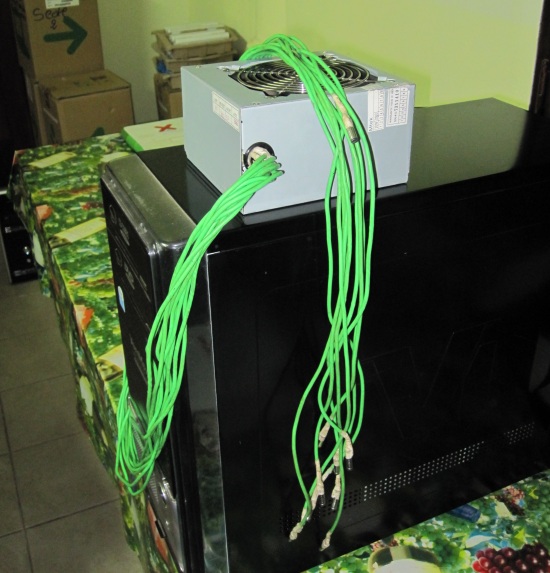One of the things that always fascinated me as a child was how all throughout history very similar inventions were often found by different people living in very different circumstances. Looking at the photos below I was strongly reminded of that notion.


The first photo shows a charger for multiple XOs that a team working on a project in India developed whereas the second one is a very similar design that is being used in the repair center in Paraguay. Both tap into the 12V lines of a standard PC power-supply to charger approximately a dozen XOs at the same time.
Damitr from India explains the need for a home-brew charger for multiple XOs in an extensive blog-post:
What we wanted is to charge a large number of XO's at one go. The desiderata was that technology should be indegenious, cheap, and should be `open'. Open is used here in the sense of being transparent to anyone who wants to repair or know its workings.
Isn't it remarkable how the solutions people in India and Paraguay came up with are similar to each other yet totally different from the charger products that OLPC is working on. Given the differences in price and availability it comes as no surprise that the ones locally developed are popular whereas the other ones are much harder to find in real life.


Email me at minifarms@gmail.com to receive this as an attachment with photos.
Ken Hargesheimer
Access to low cost technology
Photo Patrick Kamoyani
Patrick uses a 12 volt car battery with an inverter which increases the power supply from 12 volts to 240 volts – the
equivalent of mains power. He runs a laptop computer, printer and mobile phone from this. The battery lasts four to five days and he then gets it recharged in a nearby shop. He has a dial-up connection between his mobile phone and laptop and uses Bluetooth wireless technology. This means he can use his mobile phone connection to access the internet on his laptop. He finds this is much cheaper than using internet cafes. Eventually he hopes to be able to afford a solar panel to charge his car battery at home. Patrick provides a great example of how people in a remote area can benefit from technology.
Patrick lives in Western Kenya in a remote village with no electricity or landline telephone. His home, which he also uses as an office, is very simple, but he is able to use up to date technologies. He produces KiSwahili translations of development publications for a website. Footsteps www.tearfunds.org/tilz
Patrick Bunyali Kamoyani Western Kenya Email: pbkamoyani@myway.com
Ken Hargesheimer asked me to write and tell you about connecting your laptop to an auto battery more efficiently. Here is a main adapter for a laptop:
Here is an adapter made for using a laptop in an automobile cigarette lighter (which is 12 volts from battery):
This adapter converts straight from your 12 volt battery to the laptop’s power of 16 – 20 volts. To connect directly to the battery the cigarette lighter adapter would be removed and replaced with the two clips allowing a direct connection to the battery posts. Here is an example:
This can only work with an adapter made for an automobile to laptop since the input needs to be the 10-12 volts from the auto battery. I hope this is of some help. You may need to find someone who can modify such an adapter for you.
Richard Cravy
I have since discovered that one can buy dc printers for laptops.
Another way, which is simpler but maybe more expensive in some places, is to use a UPS [uninterrupted power supply]. Plug it into the 120 or 220 v and it charges the battery in the UPS. Connect your computer, etc to the UPS. In the USA they cost from $50 to $200 according to quality and to the size of the battery.
Use a solar panel to charge the battery. Solar electricity panels: Light homes, classrooms, etc. Can power radios, TVs, computers, etc. Use to recharge batteries. http://biodesign.webeden.co.uk; Graham Knight [English & French] waame.sn/ (french); Haiti - vssnet.org/index.html; Benin - gawa.nu/stories/story_solar.htm; http://ntong-benin.ifrance.com/ (french); Malawi - http://solar-aid.org/, for videos click on 'Solar videos'; Kenya - kcyp.net; Blog at http://www.solar-aid.org/?gclid=CKac4bfh3YkCFQnoEAodlVQSFA; http://www.idrc.ca/en/ev-111741-201-1-DO_TOPIC.html; Ghana - www.graphicghana.info/article.asp%3Fartid%3D14797+ghana+CASOLS&hl=en&gl=uk&ct=clnk&cd=5
Just to let you know, the XOP charging racks are being rolled out across Australia as a standard part of nearly every OLPC Au deployment and have been very well received.
Guys have you seen this?
http://wiki.laptop.org/go/Cow_Power
We wrote about the OLPC India XO Laptop Cow Power Dynamo in December 2007